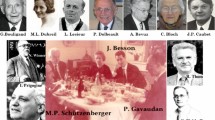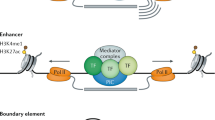Abstract
Heterochromatin represents 30% of eukaryotic genome in Drosophila and 15% in humans. Despite extensive research spanning many decades, its evolutionary significance, as well as the forces that guarantee its maintenance, are still elusive. Many theoretical and experimental approaches have led researchers to propose several conceptual frameworks to elucidate the nature of this huge mysterious genetic material and its spreading in all eukaryotic genomes. “Junk DNA” as well as “selfish genetic material” are two examples of such attempts, but several lines of evidence suggest that such explanations are incomplete. In fact, if the selfish DNA hypothesis does not explain the mapping of genetic functions in heterochromatin, then the junk DNA hypothesis is incomplete in describing both emergence of genetic functions and their maintenance in the eukaryotic heterochromatin. Recent developments in the physics of complex systems and mathematical concepts such as fractals provide new conceptual clues to answer several basic questions concerning the emergence of heterochromatin in eukaryotic genomes, its evolutionary significance, the forces that guarantee its maintenance, and its peculiar behavior in the eukaryotic cell. The aim of this paper is to provide a new theoretical framework for the heterochromatin, considering such genetic material in physical terms as a complex adaptive system. We apply some computer calculations to demonstrate the nonlinearity of the flux of genetic information along the phylogenic tree. Fractal dimensions of representative heterochromatic sequences are provided. A theory is proposed in which heterochromatin is considered a system that evolves in a self-organized manner at the edge of cellular and environmental chaos.
Similar content being viewed by others
References
Ananiev, E.V., Phillips, R.L. & Rines, H.W. (1998). Chromosome-specific molecular organization of maize (Zea mays L.) centromeric region. Proceedings of the National Academy of Sciences U.S.A. 95, 13073–13078
Bak, P. (1996). How nature works. New York: Springer-Verlag.
Bak, P. & Chen, K. (1991). Self-organized criticality. Scientific American 264, January, 46.
Barry, A.E., Howman, E.V., Cancilla, M.R., Saffery, R. & Choo, K.H. (1999). Sequence analysis of an 80 kb human neocentromere Human Molecular Genetics, 8, 217–227.
Bonaccorsi, S., Gatti, M., Pisano, C. & Lohe, A. (1990). Transcription of a satellite DNA on two Y chromosome loops of Drosophila melanogaster, Chromosoma, 99, 260–266.
Brown, K.E., Guest, S.S., Smale, S.T., Hahm, K., Merkenschlager, M. & Fisher, A.G. (1997). Association of transcriptionally silent genes with Ikaros complexes at centromeric heterochromatin, Cell, 91, 845–854.
Cairns, J., Overbaugh, J. & Miller, S. (1988). The origin of mutants, Nature, 335, 142–145.
Charlesworth, B., Sniegowski, P. & Stephan, W. (1994). The evolutionary dynamics of repetitive DNA in eukaryotes. Nature, 371, 215–220.
De Fonzo, V., Bersani, E., Aluffi-Pentini, F., Castrignano, T. & Parisi, V. (1998). Are Only Repeated Triplets Guilty? Journal of Theoretical Biology, 194, 125–142.
Devlin, R.H., Bingham, B. & Wakimoto, B.T. (1990). The organization and expression of the light gene, a heterochromatic gene of Drosophila melanogaster, Genetics, 125, 129–40.
Dimitri, P. & Junakovic, N. (1999). Revising the selfish DNA hypothesis. Trends in Genetics, 15 No. 4, 123–124.
Dobie, K.W., Lee, M., Fantes, J.A., Graham, E., Clark, A.J., Springbett, A., Lathe, R. & McClenaghan, M. (1996). Variegated transgene expression in mouse mammary gland is determined by the transgene integration locus. Proceedings of the National Academy of Sciences U.S.A. 93, 6659–6664.
Doolittle, W.F. & Sapienza, C. (1980). Selfish genes, the prototype paradigm and genome evolution. Nature 284, 601–603.
Dorer, D. & Henikoff, S. (1994). Expansions of transgene repeats cause heterochromatin formation and gene silencing in Drosophila. Cell, 77, 993–1002.
Felsenstein, M. & Emmons, S. (1988). Nematode repetitive DNA with ARS and segregation function in Saccharomyces cerevisia. Molecular and Cellular Biology, 8, 875–883.
Forsburg, S.L. (1999) The best yeast. Trends in Genetics, 15, 337–381
Gates, M.A. (1986). A simple way to look at DNA. Journal of Theoretical Biology, 119, 319–28.
Gatti, M. & Pimpinelli, S. (1992). Functional elements in Drosophila melanogaster heterochromatin. Annuual Review of Genetics, 26, 239–75.
Gatti, M., Pimpinelli, S. & Santini, G. (1976). Characterization of Drosophila heterochromatin. I Staining and decondensation with Hoechst 33258 and quinacrine. Chromosoma, 57, 351–375.
Gaubatz, J.K. (1990) Extrachromosomal circular DNAs and genomics sequence plasticity in eukaryotic cells. Mutation Research, 237, 271–292.
Goldberger, A.L. Peng, C.K., Hausdorff, J., Mietus, J., Havlin, S. & Stanley, H.E. (1996). Fractals and the Heart. In Iannaccone, P.M. & Khokha, M. (Eds), Fractal geometry in Biological systems (pp. 249–266). CRC Press, Inc.
Gupta, R.S. & Golding, G.B. (1996). The origin of eukaryotic cell. Trends in Biochemical Science, 21, 166–171.
Heitz, E. (1928). Das Heterochromatin der Moose. I. Jahrb Wiss Botanik, 69, 762–818.
Hollo, G., Kereso, J., Praznovszky, T., Cserpan, I., Fodor, K., Katona, R., Csonka, E., Fatyol, K., Szeles, A., Szalay, A.A. & Hadlaczky, G. Evidence for a megareplicon covering megabases of centromeric chromosome segments. Chromosome Research, 4, 240–247.
Iannaccone, P.M. & Khokha, M. (1996). Fractal geometry in biological systems. Boca Raton: CRC Press, Inc.
Kauffman, S. (1995). At home in the universe. New York: Oxford University Press.
Kereso, J., Praznovszky, T., Cserpan, I., Fodor, K., Katona, R., Csonka, E., Fatyol, K., Hollo, G., Szeles, A., Ross, A.R., Sumner, A.T., Szalay, A.A. & Hadlaczky, G. (1996). De novo chromosome formations by large-scale amplification of the centromeric region of mouse chromosome. Chromosome Research, 4, 226–239.
Kimura, M. (1968). Evolutionary rate at molecular level. Nature, 217, 624–626.
Labrador, M. & Corces, V.G. (1997). Transposable element-host interactions: regulation of insertion and excision. Annual Review of Genetics, 31, 381–404.
Le, M.H., Duricka, D. & Karpen, G.H. (1995). Islands of Complex DNA are Widespread in Drosophila Centric Heterochromatin. Genetics, 141, 283–303.
Mandelbrot, B.B. (1983). The fractal geometry of nature. New York: W.H. Freeman.
Martin, D.L. & Whitelaw, E. (1996). The variegation of variegating transgenes. Bioessays, 18, 918–923.
Martin, W. & M. Muller, (1998). The hydrogen hypotesis for the first eukaryote. Nature, 392, 37–41.
Moore, J. (1994). The software is available on fractdna.zip at http://iubio.bio.indiana.edu/soft/ science/ibmpc/fractdna.txt (Retrievability verified January, 2003).
Moreira, D. & Lopez-Garcia, P. (1998). Symbiosis between methanogenic archaea and δ-proteobacteria as the origin of eukaryotes: the syntrophic hypothesis. Journal of Molecular Evolution, 47, 517–530.
Nielsen, R. (1999). The molecular clock is gone but not forgotten. Trends in Genetics, 15, 442–443.
Orgel, L.E. & Crick, F.H.C. (1980). Selfish DNA: The ultimate parasite. Nature, 284, 604–607.
Palumbo, G., Berloco, M., Fanti, L., Bozzetti, M.P., Massari, S., Caizzi, R., Caggese, C., Spinelli, L. & Pimpinelli, S. (1994). Interaction systems between heterochromatin and euchromatin in Drosophila melanogaster. Genetica, 94, 267–274.
Pardue, M.L., Danilevskaya, O.N., Lowenhaupt, K., Slot, F. & Traverse, KL. (1996). Drosophila telomeres: new views on chromosome evolution. Trends in Genetics, 12, 48–52.
Peng, C.K., Buldyrev, S.V., Goldberger, A.L., Havlin, S., Sciortino, F., Simons, M. & Stanley, H.E. (1992). Long-range correlations in nucleotide sequences. Nature, 356, 168–170.
Pimpinelli, S., Berloco, M., Fanti, L., Dimitri, P., Bonaccorsi, S., Marchetti, E., Caizzi, R., Caggese, C. & Gatti, M. (1995). Transposable elements are stable structural components of Drosophila melanogaster heterochromatin. Proceedings of the National Academy of Sciences U.S.A., 92, 3804–3808.
Pimpinelli, S. Bonaccorsi, S., Gatti, M. & Sandler, L. (1986). The peculiar genetic organization of Drosophila heterochromatin. Trends in Genetics, 2, 17–20.
Pimpinelli, S. & Dimitri, P. (1989). Cytogenetic organization of the Rsp (Responder) locus in Drosophila melanogaster. Genetics, 121, 765–772.
Pimpinelli, S., Santini, G. & Gatti, M. (1976). Characterization of Drosophila heterochromatin II. C-and N-banding. Chromosoma, 57, 377–386.
Prescott, D.M. (1994). The DNA of ciliated protozoa. Microbiological Review, 58, 233–267.
Schultz, J. & Dobzhansky, (1934). The relation of a dominant eye color in D. melanogaster to the associated chromosome rearrangement. Genetics, 19, 344–364.
Sole, R.V., Manrubia, S.C., Benton, M., Kauffman, S. & Bak, P. (1999). Criticality and scaling in evolutionary ecology. Tree, 14, 156–160.
Spellman, P.T. & Rubin, G.M. (2002). Evidence for large domains of similarity expressed genes in the Drosophila genome. Journal of Biology, 1:5, p. 9.
Spofford, JB. (1976). Position-effect variegation in Drosophila. In Ashburner, M. & Novitski, E. The genetic and biology of Drosophila, (Vol. 1C, pp. 955–1018). New York: Academic Press.
Sprott, C. J & Rowlands, G. (1995) Chaos Data Analyzer. New York: Physics Academic Software American Institute of Physics.
Stanley, H.E. (1995) Power laws and universality. Nature, 378, 554.
Stanley, E.H., Buldyrev, S.V., Goldberg, A.L., Havlin, S., Mantegna, R.M., Peng, C.K. & Simons, M. (1996). Scale invariant features of coding and noncoding DNA sequences. In Iannaccone, P.M. & Khokha, M. (Eds.), Fractal geometry in Biological systems (pp. 249–266). CRC Press, Inc.
Viseck, T. (1992). Fractal growth phenomena, Singapore: World Scientific.
Wakimoto, B.T. & Hearn, M.G. (1990). The effects of chromosome rearrangements on the expression of heterochromatic genes in Chromosome 2L of D. melanogaster. Genetics, 125, 141–54.
Wallrath, L.L. (1998). Unfolding the mysteries of heterochromatin. Current Opinion in Genetics and Development, 8, 147–153.
Weiler, K.S. & Wakimoto, B.T. (1995). Heterochromatin and gene expression in Drosophila. Annual Review of Genetics, 29, 577–605.
Wolfe, K.H. & Shields, D.C. (1997). Molecular evidence for an ancient duplication of the entire yeast genome. Nature, 387, 708–713.
Wu, C.I., Lyttle, T.W., Wu, M.L. & Lin, G.F. (1988). Association between a satellite DNA sequence and the Responder of Segregation Distorter in D. melanogaster. Cell, 54, 179–89.
Wu, C.I., True, J.R. & Johnson, N. (1989). Fitness reduction associated with the deletion of a satellite DNA array. Nature, 341, 248–51.
Author information
Authors and Affiliations
Corresponding author
Rights and permissions
About this article
Cite this article
Spinelli, G. Heterochromatin and Complexity: A Theoretical Approach. Nonlinear Dynamics Psychol Life Sci 7, 329–361 (2003). https://doi.org/10.1023/A:1025980007520
Issue Date:
DOI: https://doi.org/10.1023/A:1025980007520




